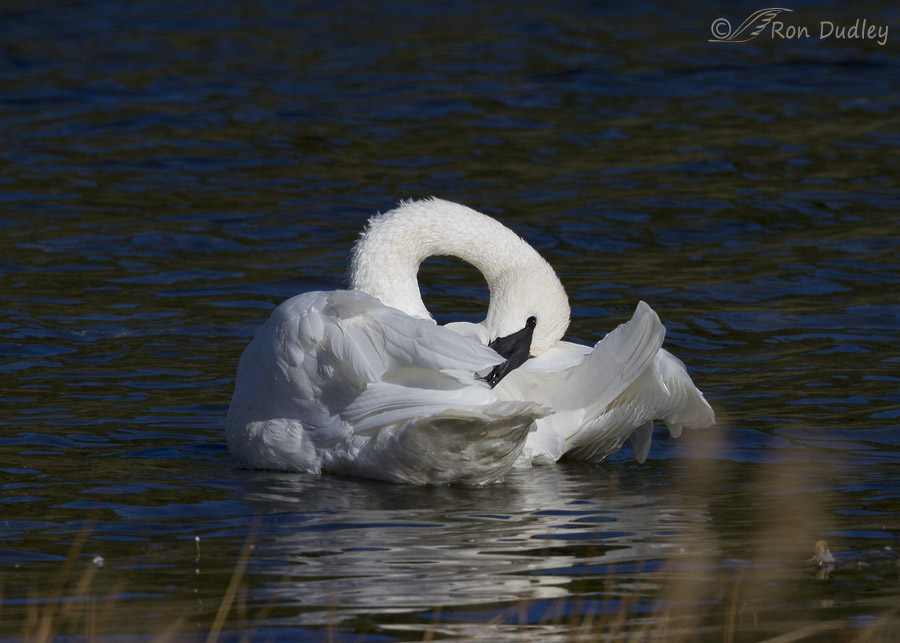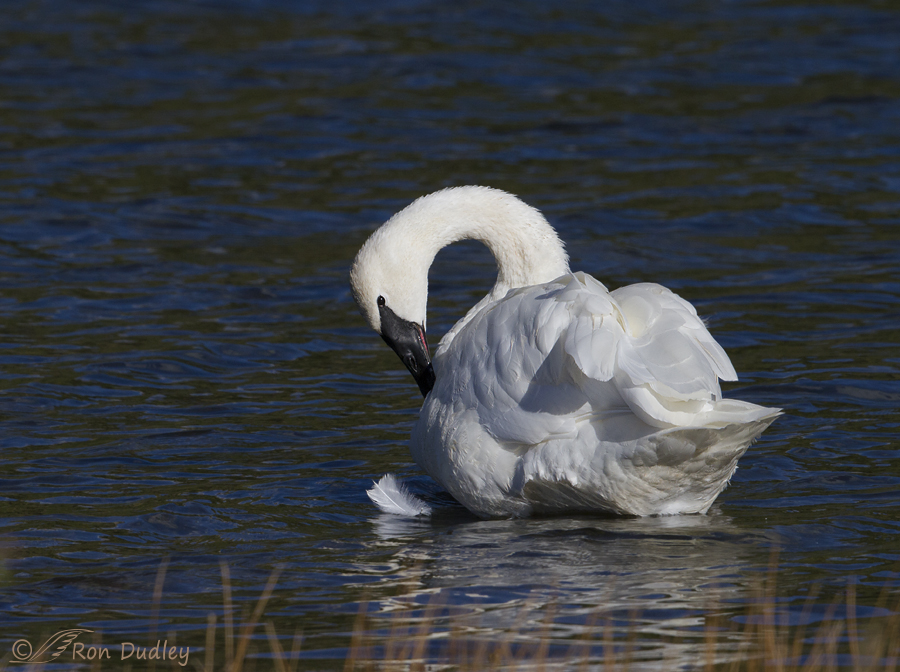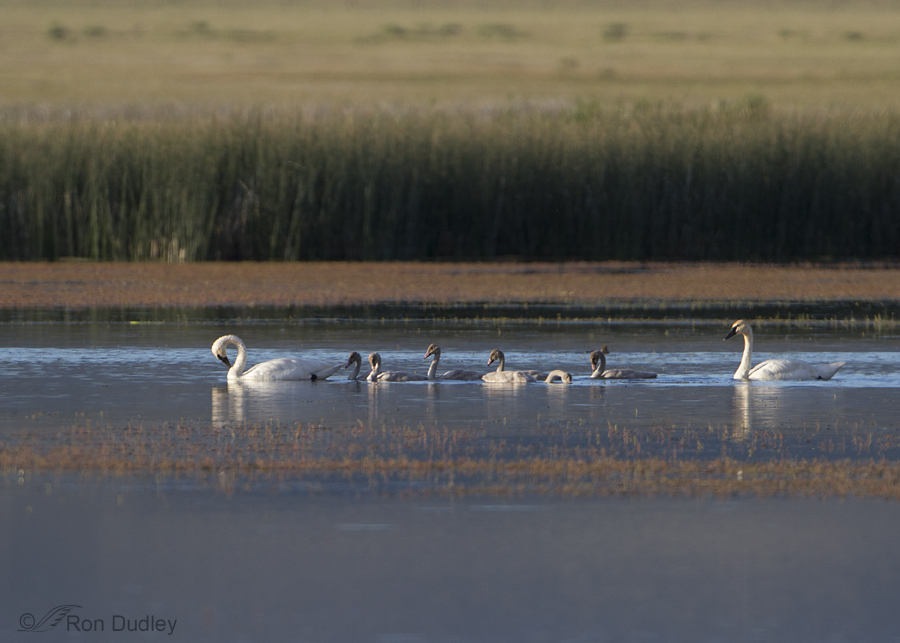I may not be successful but I’m going to try to keep today’s post as short as possible. I went off on an extended rant recently and I’d prefer not do it again. Not so soon anyway.

This is an older photo of a Trumpeter Swan as it was preening on Elk Lake in southwest Montana. Trumpeter Swans are the heaviest native bird species in North America, weighing up to 33 lbs. That’s about twice the size of the much more common Tundra Swan which is far from a lightweight.
By 1932, largely due to high demand for their primary feathers, meat and skins, only 69 Trumpeter Swans were known to exist and those known birds were found near Yellowstone National Park which led to the establishment of nearby Red Rock Lakes National Wildlife Refuge in Montana’s Centennial Valley in 1935. The refuge, whose border is only about a mile from Elk Lake where these first two photos were taken, played a major role in bringing Trumpeter Swans back from the brink of extinction.
The drastic historic decline of Trumpeter Swans began during the early fur trade and settlement of western North America by Europeans. Following is a quote (typos corrected) from Ed Forbes, an early Kalispell, Montana rancher, that illustrates the prevailing attitude of the time:
“I punched cows in the Centennial Valley in Beaverhead County from 1883 to 1888. During that time I saw quantities of swans, and killed many young birds which we thought good to eat. We used to paddle after them among the tulies (bulrushes) and rope them, as they never seemed to learn to fly until ice formed around the shores, and were fearless, big, and awkward. Even then it took them a long, flapping flight to clear the water. The young birds would dive, and come up at a distance of 600 feet when chased with a boat.”

These swans are massive, magnificent and elegant birds. This one lost a feather while it was preening and watched it slowly drift away.

Trumpeter Swans actually breed at Red Rock Lakes NWR and several times I’ve been lucky enough to see and photograph families of them right from my campsite on Lower Red Rock Lake. I actually took this photo from inside my camping trailer. Average clutch size for the species is five so to see six youngsters raised to this size was a sight to behold.
Utah hunters, who can legally hunt Tundra Swans, apparently can’t tell the difference between a 30+ lb. Trumpeter Swan and a 16 lb. Tundra Swan.
Three days ago Utah’s DWR announced that for the third year in a row, Utah’s Tundra Swan hunt came to an early close after the Trumpeter Swan harvest breached a 20-bird quota set to limit the hunts impact on Trumpeters migrating through Utah from the Yellowstone region. Utah’s hunters are supposed to be shooting Tundra’s but many of them are shooting Trumpeters instead. And there’s fear that at least some of them are doing it deliberately because Trumpeter Swans are considered to be such a “trophy” (I hate that word in a hunting context).
This post is already far longer than I wanted it to be and I feel my blood pressure rise as I type this so if you’d like more information about what’s going on in Utah with Trumpeter Swans and hunters please refer to this link from a Salt Lake Tribune article from three days ago.
If I were King of the World I’d ban hunting of swans of any species, hunting of all predators and trophy hunting. I’d also make trapping of any and all wildlife strictly illegal, with harsh penalties for those who persist. And I’d get rid of the federal government’s notorious and deliberately misleadingly-named “Wildlife Services”.
But then I’m not King and I’m not likely to be anytime soon.
Ron
Notes:
- Whether or not you’re a fan of John James Audubon (there are folks in both camps), in 1840 he described his time spent with Trumpeter Swans in an accurate and elegant way that shows that at least some folks back then had great appreciation for these splendid birds:
“For a perfect conception of their beauty and elegance, you must observe them when they are not aware of your proximity, as they glide over the waters of some secluded inland pond. The neck, which at other times is held stiffly upright, moves in graceful curves, now bent forward, now inclined backwards over the body. The head, with an extended scooping movement, dips beneath the water, then with a sudden effort it throws a flood over its back and wings, while the sparkling globules roll off like so many large pearls. The bird then shakes its wings, beats the water, and, as if giddy with delight, shoots away, gliding over and beneath the surface of the stream with surprising agility and grace. Imagine a flock of fifty Swans thus sporting before you. I have more than once seen them. And you will feel, as I have felt, happier and freer of care than I can describe.” — J. J. Audubon
- Utah hunting regulations are vague about whether it’s technically legal or not to hunt Trumpeter Swans. DWR says that they “strongly discourage” hunters from hunting them.
- Obviously, I failed in my desire to keep this post short. Sorry.


Ron .. wildlife has lost out and The Div of
Parks and wildlife doesn’t care . It’s about humans . Recreation !! I have gone to their offices personally to put in complaints and my local audubon club here has also . They don’t care ….
I am on board with virtually all of this post but would take exception regarding one point. In my part of the country–the western side of the Sierra Nevada–the US Fish and Wildlife Service is a huge asset to watershed conservation/restoration efforts. While they necessarily focus the bulk of their time and efforts on the larger rivers and their salmon and steelhead fisheries, in my volunteer restoration/conservation and public education work on one very small, largely rain fed watershed (with only an episodic salmon and steelhead “fishery”) USF&W staff have been our longest serving and most dedicated professional collaborators. These federal employees have consistently gone above and beyond in their support of our work addressing the issues facing our little stream. From attending volunteer steering committee meetings to providing expert learning stations for outreach and education days for school age youth USF&W has proven a true friend and role model of responsible stewardship time and again. I know this is not the case in every locality and regarding every species for which federal wildlife agencies may have responsibility but–to be fair–in my neck of the woods they are providing great service to wildlife and wildlands.
Jim, I believe you misread or misunderstood what I said. I have no beef with the USFWS. I’m grateful for them and what they do.
“Wildlife Services” is a completely different agency under the USDA. They’re a wildlife killing machine. Here’s an excerpt from a Washington Post article:
“The more than 4 million animals shot, poisoned, snared or trapped by the Department of Agriculture’s Wildlife Services in fiscal year 2013 included 75,326 coyotes, 866 bobcats, 528 river otters, 3,700 foxes, 12,186 prairie dogs, 973 red-tailed hawks, 419 black bears and at least three eagles, golden and bald.”
And here’s a link to that article:
https://www.washingtonpost.com/national/health-science/governments-kill-of-4-million-animals-seen-as-anoverstep/2014/06/06/1de0c550-ecc4-11e3-b98c-72cef4a00499_story.html
You are correct Ron. I did misunderstand that you were making reference to a particular government agency…which doesn’t seem to have a high profile out here on the Left Coast. Mea culpa!
Jim, I’ll take most of the responsibility for the misunderstanding. Those two names are so very similar I should have anticipated there would be some confusion and worded what I said more carefully.
I’ve been meaning to publish a post about Wildlife Services anyway so I may do that soon and hopefully accomplish two things – clear up any misunderstanding that resulted from this post and further expose the nefarious activities of Wildlife Services.
Your lovely photos of Trumpeter Swans at Red Rock Lakes was how I happened upon Feathered Photography.
Google Images pointed me to this post: https://www.featheredphotography.com/blog/2013/07/27/trumpeter-swan-pair-with-six-cygnets/
I’ve always been fascinated by Trumpeter Swans ever since I read E.B White’s The Trumpet of the Swan in the school library during recess. I had to use my imagination for their calls – described like a “French horn” resounding through the air (this was before the days of youtube). I even did a project on them in high school and was devastated by how they were nearly hunted to extinction!
Thankfully they’re slowly making a comeback. Red Rock Lakes is one of those places – far away from greedy humans, as they should be.
I only expected to read that one post and maybe the “Just a Shot That I Like” series, and I’d be done with it. But here I am, reading two posts a day – the daily one and backtracking by the years (started from the very first post and am currently in 2015).
You could say I came for the swans but stayed for more birds and gaining knowledge in biology, photography, history, and ethics. And of course getting to know, the humble photographer behind these photos. 🙂
I adored your comment, Amy. What a great way to end an otherwise unpleasant and mostly unproductive day. Thanks very much.
I agree with Sheila. Please don’t lose your passion, Ron. Rather than King, I would love to see you in charge of the US Dept of the Interior and the US Fish & Wildlife Service. Trophy and sport hunting should be outlawed but even where it is banned poachers find ways to kill beautiful animals that have no defense from a shot gun or high powered rifle or snare trap. I wish I had the solution. I find that I want to beat grinning trophy hunters that pose with their “kills” to a pulp. If reincarnation is real then maybe they will come back as the hunted being pursued and running scared. Karma
Melanie, when it comes to trophy hunting I hope your version of karma comes to fruition.
I have all sorts of inappropriate things to say about hunters who can’t tell size. I imagine their 6” is way off.
I’ll stop now.
I enjoyed that, Arwen!
I just lined up to the Utah DWR Swan ID test, which is required to get a Swan hunting license. It was very easy, of course. However, I think the requirement to report is a fool’s game, akin to expecting all drivers to observe the speed limit.
I think hunting swans, or anything for that matter, should only be allowed if the animal is trained how to use a gun. Impossible, or course, but if it were it would sure even up the playing field. Like the old blues song: “There wouldn’t be so much huntin’ if the rabbit had a gun”.
“I think hunting swans, or anything for that matter, should only be allowed if the animal is trained how to use a gun.”
Lyle, I just decided. I want YOU to be King of the World!
I’m afraid that ID test isn’t the only “fool’s game” going on in Utah.
Don’t get me started … but then you’re probably already aware how I feel about the whole topic. This, however, is particularly depressing to think about. These beautiful creatures do not deserve such treatment (not that any do, in my mind). So rant away, King Ron. If only you could just decree an end to it.
Chris, now that would be a decree that I’d support.
Hunting for food is one thing. Hunting for ‘spor’t is a very different thing and I would happily ban it.
Rant away – but leave room on the soap box for me.
There’s ALWAYS room for you on my soap box, EC.
I am not a hunter but I am all for hunting and feel that you have a right to hunt and also feel that hunters put a lot of money into the wildlife management areas. I don’t like the fact that hunters blame predator’s for killing all the “trophy” animals. Predator’s are not going after the biggest strongest animals they are going after the easiest. I recently read that hunting guides around Yellowstone are watching Yellowstone posts on Facebook and else where to see where wolves are at and where they might leave the park so they can get that “trophy”. I have also read that hunters in Utah are watching e-bird so they can see where rarities are to get that “trophy”. Those are the things I don’t agree with. If you want to hunt for the meat I’m all for it but hunting for a wall hanger is not right.
Dan, around here some hunters regularly follow bird photographers, including me, online for the purpose of locating ‘trophy’ ducks to shoot. Several years ago that’s how hunters located and killed several Harlequin Ducks at the second bridge on the Antelope Island causeway. To them those ducks were trophies. That’s one of the reasons I don’t report the precise location of rare or unusual birds on my blog.
I need to be careful not to start my own rant. Many years ago while on a Christmas Bird Count, I went charging after someone shooting at a small flock of Tundra Swans flying by. Fortunately, he was so incompetent that he missed. Hunting any swans then was illegal. The hunter told me he thought they were Snow Geese, which of course look very different and are very, very uncommon here in the valley while several Tundra Swans were then always present on that reservoir each winter. At the time it was being debated whether a Tundra Swan season should be allowed. One member of my count team sometimes hunted ducks in the past. In his opinion swan hunting was only desired by incompetents. He said they are big, fly low and slow and make an easy target for those with no skill to do anything else. He felt that anyone who could only shoot a swan shouldn’t be allowed to have a hunting license at all.
Dan, they’d sure be hard to miss, especially with a shotgun.
I talked to a couple of hunters this morning. Both of them thought swan hunting was distasteful (for lack of a better word).
Thank you Ron Dudley!
You’re very welcome, Susan.
We get the beautiful Tundra Swans here during migrations and very often 5 to 10 will stay for quite a while. I can not even image killing these birds. And hard for hunters or anyone to confuse them for Trumpeter Swans.
Ron, I have often spouted off about what I would do if KING. I guess neither of us will ever be, but I would certainly join you on many wildlife and environmental issues.
Thanks for posting. And please – never apologize for length.
Everett, try to imagine a swan twice as big as a Tundra. Seeing them up close really gets your attention.
Ron for King!!
I don’t want it, Cathryn. But if I were King I’d sure as hell make some changes and they certainly wouldn’t be limited to hunting regulations.
Be nice if they could start catching some of the “jerks” and fine them heavily but that isn’t likely to happen unfortunately. ;( “In theory” one is supposed to know what one is shooting at and ignorance is no excuse. Why in MT an occasional Llama or cow gets taken for deer tho seems to be fewer in recent years. Doesn’t stop the flat out poaching tho. 🙁
Judy, I get the impression that they usually know who’s shooting them. Swans that have been taken have to be checked by DWR so they can confirm the species and take measurements etc. I’ve actually watched as a DWR officer carefully checked a swan that was taken by a hunter.
But if the hunter shot a Trumpeter and he/she has a license for swans they aren’t cited or charged. That needs to change!
As long as we continue to kill beautiful things “for fun” our collective soul will continue to rot.
If you get to be king of the world, can I be your Forestry Tyrant?
“If you get to be king of the world, can I be your Forestry Tyrant?”
Absolutely, Porcupine. Consider it preordained.
This is a deserved rant. In the Salt Lake Tribune they discuss mandatory education for the hunters – which might have the opposite effect. I suggest an equally probably unlikely to succeed solution – mandatory reading of the Trumpet of the Swan by EB White. Or even better – listening to the great man reading it out loud. A classic for children and grandparents and everyone else.
Thanks, Frances. Actually I don’t think anything would work better with some of these hunters than an outright ban on all swan hunting. But mandatory reading of White’s book couldn’t hurt.
Ah, touching and sad. Humans, geez, why can’t we appreciate. As often I thought as I saw these photos, well these are the most beautiful yet. I’m now visiting in Florida :(.
Thank you, Ron!
Thanks very much, Mary. I can’t answer your question.
I’ve had the pleasure during migratory season of watching both swans at Oxbow Lake in Maryland which is off limits to hunters (https://www.nature.org/en-us/get-involved/how-to-help/places-we-protect/oxbow-nature-preserve/). I don’t know how anyone with an appreciation for natural beauty could shoot at a swan! Juvenile brains?
“Juvenile brains?”
Terri, I think that’s part of the problem in at least some instances.
Amen. Never apologize for your passion Ron.
Thanks, Sheila. I only apologized for the ‘length’ of my passion… 🙂